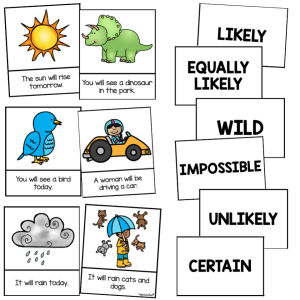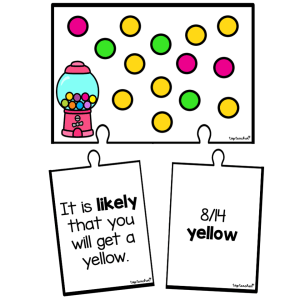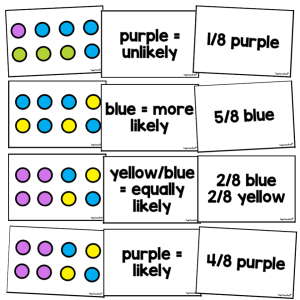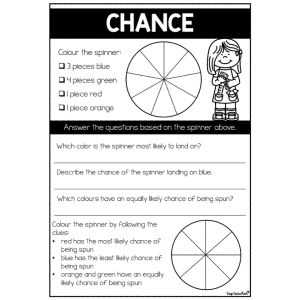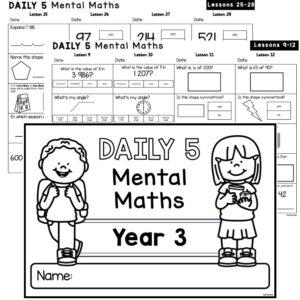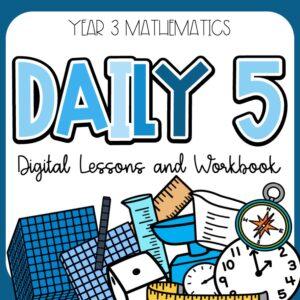Chance Statement Worksheets

Description
Support your students as they explore the language of probability with our Chance Statement Worksheets – a versatile set of worksheets designed to build understanding of key chance terms such as “will,” “will not” and “might.” Through engaging tasks that blend colouring, sentence work and visual cues, students are guided to think critically about the likelihood of events and match outcomes to appropriate language. These worksheets make abstract ideas accessible by combining concrete images with familiar real-world scenarios.
Each worksheet presents students with clear, structured opportunities to describe events based on their likelihood. Students are asked to analyse simple statements, sort outcomes, and colour objects to reflect the probability described – for example, colouring all the umbrellas that might be used on a cloudy day. By matching visual information with written language, students reinforce their understanding of how probability terms apply in practical situations. The repetitive, low-stakes format is ideal for building confidence and fluency in using chance vocabulary.
The Chance Statement Worksheets are ideal for Foundation to Year 2 students and can be used during your chance and data unit or as a cross-curricular link with literacy. The mix of sentence work, visual interpretation and creative colouring tasks means students remain engaged while practising critical thinking and decision-making. These worksheets are perfect for independent work, small-group rotations, formative assessment or as part of a whole-class discussion. Simply print and go!
Key Learning Outcomes:
- ✅ Use probability terms such as “will,” “will not” and “might” correctly
- ✅ Recognise and describe the likelihood of events in everyday contexts
- ✅ Match written statements with visual representations of outcomes
- ✅ Build vocabulary and reasoning skills related to chance and prediction
- ✅ Develop early data literacy through sentence and sorting tasks
What’s Included:
- A collection of printable worksheets using “will,” “will not” and “might” to describe events
- Visual tasks requiring students to colour items according to chance-based prompts
- Opportunities to sort or match events based on their likelihood
- Simple sentence-based reflections and responses for young learners
- Teacher-friendly layout for easy classroom use or early finisher work
Materials Needed:
- Printed worksheets
- Coloured pencils, crayons or markers
- Optional: scissors and glue for sorting-style tasks
How to Use:
- Introduce students to the key terms: “will,” “will not” and “might.” Use classroom examples to model how they describe chance.
- Distribute worksheets and review the instructions with your class.
- Guide students to read each statement and colour or respond appropriately.
- Encourage students to explain their thinking and discuss their choices with a partner or group.
- Use completed worksheets as a basis for class discussion or portfolio evidence of learning.
Ideas for Classroom Use:
- 💡 Use as a whole-class task during your chance and data unit
- 💡 Include in your maths rotations for small group or independent work
- 💡 Use sentence stems to support oral language development before writing
- 💡 Extend the task by asking students to write their own chance-based sentences
- 💡 Pair with real-world activities such as weather forecasting or classroom routines
Teacher Tips:
- 💛 Display key chance words on your maths word wall during the activity
- 💛 Model how to read and interpret the picture before starting each worksheet
- 💛 Encourage students to use reasoning language: “This might happen because…”
- 💛 Laminate worksheets for use with whiteboard markers in small groups
- 💛 Use finished worksheets as prompts for student-led explanation or sharing
Chance Statement Worksheets provide a structured, visual and language-rich way for students to practise key probability terms – helping them describe the world around them with confidence and clarity!
Additional information
| Australian Curriculum Code | AC9M3P01, AC9M4P01 |
|---|---|
| File Format |
Australian Curriculum V9
F - 6
Lorem ipsum dolor sit amet, consectetur adipiscing elit.
Lorem ipsum dolor sit amet, consectetur adipiscing elit.
Lorem ipsum/ Lorem ipsum/ Lorem ipsum
Lorem ipsum dolor sit amet, consectetur adipiscing elit.
Lorem ipsum dolor sit amet, consectetur adipiscing elit.
Lorem ipsum/ Lorem ipsum/ Lorem ipsum
Lorem ipsum dolor sit amet, consectetur adipiscing elit.
Lorem ipsum dolor sit amet, consectetur adipiscing elit.
Lorem ipsum/ Lorem ipsum/ Lorem ipsum
Lorem ipsum dolor sit amet, consectetur adipiscing elit.
Lorem ipsum dolor sit amet, consectetur adipiscing elit.
Lorem ipsum/ Lorem ipsum/ Lorem ipsum
Lorem ipsum dolor sit amet, consectetur adipiscing elit.
Lorem ipsum dolor sit amet, consectetur adipiscing elit.
Lorem ipsum/ Lorem ipsum/ Lorem ipsum
